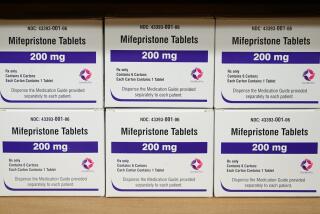Should you be taking a statin? You might be surprised
Are you among the more than 70 million American adults who should be discussing the possibility of statin therapy with a physician to reduce your risk of heart attack or stroke? For many, the answer may come as a surprise.
Getting that answer is easier than you might think too: An online calculator issued Tuesday by the American College of Cardiology and the American Heart Assn. is available to all.
The calculator considers factors such as age, gender, race, total cholesterol levels and triglycerides, high-density lipoprotein levels (HDL cholesterol, which at high levels is protective against heart disease), whether you have diabetes and/or high blood pressure, and smoking status. Fill in those answers, and the calculator will tell you--drawing on decades of research--how likely you are, over the next 10 years, to suffer a heart attack or stroke caused by atherosclerosis, or plaque-clogged arteries.
Under the new clinical practice guidelines issued Tuesday by the American College of Cardiology and the American Heart Assn., adults who have a 7.5% probability of having such a medical crisis should have a statin medication regimen recommended to them. Though this calculator is new, physicians have been tallying patients’ heart attack risks for some time, and generally believed that only those with a 10-year heart attack risk over 20% needed to be on cholesterol-lowering medication.
“You can’t guess at this,” says Cleveland Clinic cardiologist Dr. Steven Nissen, who generally applauded the new guidelines. “You have to use the calculator.”
Three groups of patients should not bother with the calculator, and instead run--not walk--to pick up their statin prescriptions. Those are: Patients who have already suffered a stroke or heart attack caused by atherosclerosis or who have established coronary heart disease; patients between the ages of 40 and 75 years old with a Type 2 diabetes diagnosis; and adults with LDL cholesterol levels of 190 or more, which generally is caused by a genetic variation that causes their livers to overproduce cholesterol.
Generally, the new recommendations suggest that heart attack and stroke survivors and people with familial hypercholesterolemia should get a high dose of statin medicine, in line with their higher 10-year risk of suffering such an event. Diabetics and people whose risk calculator puts them above 7.5% generally should opt for a moderate-dose regimen, which is less likely to produce side effects such as muscle pain and fatigue.
We know that ethnicity as well as age and gender confers different heart and attack and stroke risks. And though the calculator factors in gender and age, it offers only two choices for race: White and African American. The authors of the new guidelines said that as more targeted research provides details, they hope to add in the risk of heart attack and stroke specific to Asian and Latino patients. Until then, they recommend that patients identify themselves by gender and age and leave ethnicity blank.
Other measures, too, may one day find their way into the risk calculators. These are readings that many physicians already know and take for patients. They include factors that are easy to recognize: a family history of premature heart disease in a first-degree relative; and an ankle brachial index, essentially a systolic blood pressure reading done at the ankle. Others are more complex: coronary calcium scoring, derived from radiological scans of the arteries feeding blood to the heart to look for signs of deposited calcium; and a C-reactive protein test, a key indicator of systemic inflammation.
Right now, these suspected “biomarkers” for risk are blinking yellow lights: Certain readings appear to indicate a patient is more likely to suffer a stroke or heart attack because of clogged arteries, but the research evidence is inconsistent or incomplete. If a physician has ordered such tests and sees worrisome measures--or if a family history of early heart attack or stroke is clear--those might tip the balance in favor of statin therapy.
For those who are not swept into a statin regimen by the new guidelines, don’t get smug: For the 36% of American adults who are obese and otherwise healthy, for instance, there’s no call for complacency. A study published this week in the journal JAMA Internal Medicine found that even in the absence of metabolic syndrome--a cluster of risk factors that suggests imminent diabetes risk--obesity alone accounts for somewhere between 75% and 88% of the increased cardiovascular disease risk seen in the obese.
Less heralded Tuesday were guidelines issued by the American College of Cardiology and American Heart Assn. on “Lifestyle Management to Reduce Cardiovascular Risk.” Mainly aimed at primary care physicians treating obese patients, the new guidelines recommend that physicians organize meetings led by a trained coach that would give obese patients at least six months of intensive counseling aimed at reducing weight and stepping up physical activity. Where that’s not feasible, they suggested offering patients online or telephone programs or referring them to commercial programs.







